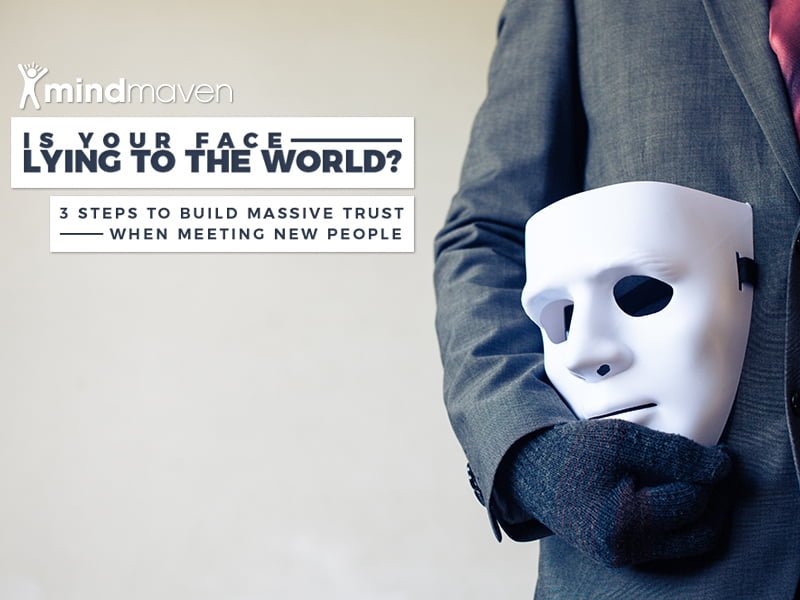In business and in life, trust is one of the most vital aspects of successful relationships. Yet despite this, many struggle to quickly and consistently build and maintain trust as they meet new people.
That’s why, as an executive coach, when I teach my clients how to leverage their network and deepen their relationships, the core of every strategy is a simple concept: Building trust.
When it comes to building trust, there are the obvious tips you’ve probably heard before. For example: Be honest and follow through on your commitments.
And while those are great tips, we often forget that the decision to trust someone is usually made long before you’ll get a chance to establish a pattern of honesty and follow-through.
In fact, the decision to trust is often made before you even open your mouth to introduce yourself. And influencing that factor that’s what I want to talk about today.
The Unspoken Heart of Communication
This might seem disconnected from the topic, but bear with me: Do you ever wonder why we as a culture still love meeting in person?
With the rise of technology and the ease of phone calls and video conferences, why do most people still prefer to meet face-to-face?
The answer’s simple: Because communication isn’t a one-dimensional act. In fact, it has three core elements:
- The words we speak,
- The tone we use, and
- The visual cues we provide.
We feel comfortable with someone—and we trust them—when their communication is congruent; meaning each of the three components of communication is in alignment and sending the same message.
And the only way we can effectively communicate using all three components is by meeting face-to-face. But here’s where things get interesting: The three components are not created equally.
In a groundbreaking study, UCLA professor Albert Mehrabian discovered that the actual words we say only play a small part in the message we communicate. Specifically, he discovered that …
- The words we speak account for 7% of the message we communicate,
- The tone we use accounts for up to 38%, and
- The visual cues we provide account for a staggering 55%.
To see the effects of this concept in action, look no further than text messages or emails. Have you ever sent an message that the recipient completely misunderstood? For example: Maybe you meant something in light-hearted jest that was interpreted as a personal insult?
To some degree or another, most of us have experienced this type of misalignment in communication. And that’s because written messages lack the tonal and visual cues to fully communicate the message we intended.
When the brain lacks this vital information, it fills the gaps with assumptions. Unfortunately, these assumptions are often wrong and are heavily influenced by circumstances and state-of-mind.
That’s why face-to-face meetings are still the default choice for many people. Because although the same words could probably be communicated via text, email, or phone calls, the message itself will be incomplete and susceptible to misunderstanding.
In other words: Face-to-face meetings are still the most effective, efficient way to build relationships and establish trust. And this leads me to believe two things:
First: No matter how much technology evolves, in-person meetings aren’t going anywhere. Second: Technology will continually try to emulate the face-to-face environment the best way it knows how.
Quick tip: Make a lot of video calls? Check out How to Make Video Calls More Personal in 60 Seconds or Less.
The Importance of Congruent Communication in Building Trust
So face-to-face meetings are important because they allow us to communicate congruently and deliver a richer experience by aligning our words, our tone, and our visual cues.
But that’s in a perfect world. Sometimes, even in an in-person environment, we still struggle to communicate congruently.
For example: Have you ever entered a meeting in a bad mood due to outside circumstances? Maybe your kid’s sick, a major deal fell through, or you spilled coffee on yourself during the commute.
Whatever the reason, you’re not in a good mood. And although you might put on a happy face, you’re probably still making the wrong first impression the moment you walk into the meeting.
Your stance is likely rigid and unwelcoming. Your eyes won’t light up to match the polite-but-insincere smile. You’ll say, “It’s great to meet you,” but your inflection will clearly communicate something like, “I’d rather be elsewhere.”
That’s incongruent communication: When the words you say don’t match your vocal tone or visual cues. And the moment the other person picks up on that misalignment, even on a subconscious level, the damage is done.
And make no mistake: Most people will notice. At that point, you’ve made it much harder to gain the trust you need to establish a value-focused relationship.
3 Tips to Build Trust by Communicating Congruently
If you’ve been in business for any amount of time, you’ve probably found yourself on both sides of that equation: Both as the person who communicated incongruently, and as the person who picked up on incongruent communication.
If so, you know how painful that can be. So what can you do to overcome this tendency? Let’s start with the obvious: There’s no “faking” a good mood. You’ve got to actually want to be present with this person and you must genuinely believe what you say.
The good news is, shifting your mood and aligning your communication isn’t as hard as you might think; and it all starts with adopting a new mindset.
Here’s 3 tips you can practice before any meeting to align your communication and build trust the moment you walk through the door.
#1: Create Awareness Around Your Moods
The first thing you’ve got to do is become aware of your state of mind prior to stepping into the meeting. How and what are you feeling?
- Anger about the lost deal?
- Worry over your sick kid?
- Frustration over your spilled coffee?
These thoughts need to be replaced with a genuine excitement about meeting the other person. But before you can replace your thoughts, you need to label them. Are they …
- Positive and beneficial, or
- Negative and detrimental?
Once they’ve been labeled, ask yourself:
Will this state of mind positively influence the outcome of this meeting? If the answer’s “yes,” you’re good to go. If the answer’s “no …”
#2: Hack Your Moods with This One Question
If you aren’t in a genuinely positive mindset about the meeting, take a few moments to intentionally change your outlook by shifting your focus.
Ask yourself: “If I really wanted to be excited about this meeting, what could I be excited about?” Find a genuine reason to want to be there, and focus all your energy on that.
This doesn’t mean you’re saying your negative emotions don’t matter; you’re just compartmentalizing and setting them aside for the time being, to be focused on and resolved once you can give them the thought and attention they deserve.
You’ll know you’re in the right mindset when you can say (and genuinely believe), “It’s really great to meet you today, I’ve been looking forward to this.”
#3: Practice the Duchenne Smile
You can’t fake an authentic smile.
Research has shown time and time again that when you try, the smile lines around your eyes don’t crinkle and your eyes don’t gleam in the same way they would if the smile was genuine.
And although the difference is subtle, our brains have evolved to pick up on these slight differences. So before you enter a meeting, you need to find a reason for a Duchenne Smile.
A Duchenne Smile is a genuine smile created by real feelings of happiness and joy. If your reason for a Duchenne Smile isn’t the meeting itself, then look outside the meeting. Ask yourself, “What in my life have I enjoyed recently?”
This could be anything from a recent date with your spouse to time with your kids to closing a major deal; any memory that brings a genuine smile to your face. Conjure up that memory and focus on it intently until you feel yourself smiling.
Want to learn more about how to master the art of the Duchenne Smile? Check out The Simplest Trick to Walk into Any Meeting Smiling.
What if Circumstances Prevent a Duchenne Smile?
Every once in a rare while, you may find yourself in a situation where you’re just too stressed, worried, or otherwise distracted to communicate congruently.
Even in these instances, my recommendation is not to try and fake it. If you can, reschehdule the meeting to a better time. And if you can’t, be completely honest the moment you walk in the door.
You don’t necessarily need to go into details, but let the other person know you’ve had a rough day and apologize in advance if you seem to be giving them mixed signals.
Let them know you do genuinely want to be there and are excited to meet them, it just hasn’t been your day. I think you’ll find that most people appreciate the honesty.
How to Resolve Incongruent Communication from the Other Person
So far, this article’s focused on how you can communicate congruently. But as you begin to practice these strategies, you’ll find it isn’t you who’s communicating incongruently. It’s the other person.
And when you notice this, don’t let the meeting continue without addressing it. A lack of congruence creates a lack of trust, and a meeting that’s negatively impacting the trust levels within the relationship isn’t just a waste of time; it can be downright harmful.
Take the opportunity to practice empathy by asking them what’s on their mind and if everything’s alright. Usually you’ll pick up on this misalignment within the first few minutes of the meeting, and if you start the meeting off with a question like that you’re opening the door for them to share what’s going on.
If they’re willing to be vulnerable with you, this can lead to a surprisingly deep conversation that will build trust more effectively than just about anything else you can do.
How to Deliver Great Experiences at Scale
That’s it: If you practice the tips in this article, you’ll be delivering great experiences to your 1:1 and small group meetings in no time.
But what about at scale? For example: How do you deliver exceptional experiences at networking events, when you only have a few minutes to make a great impression?


